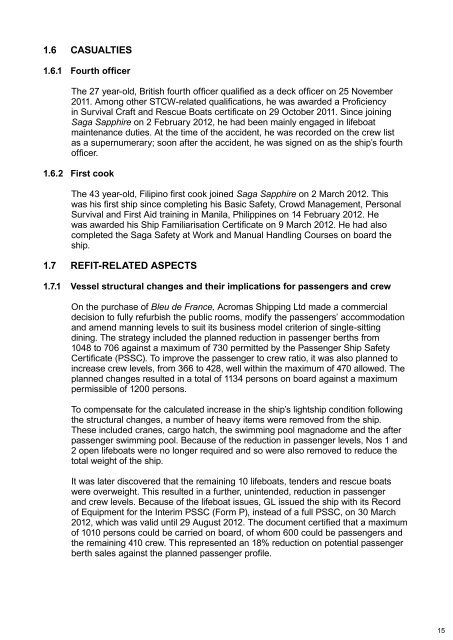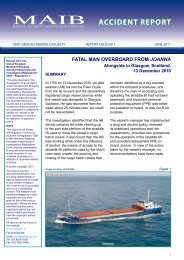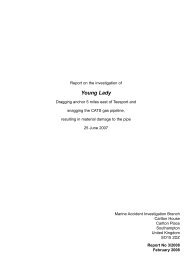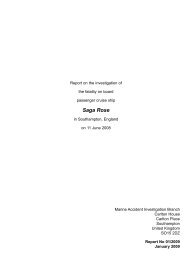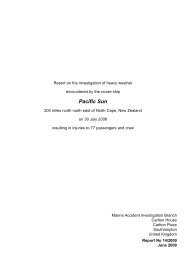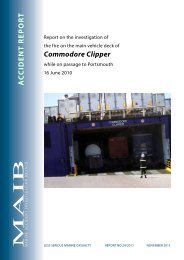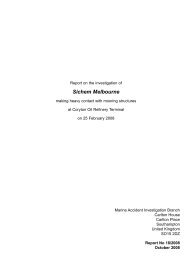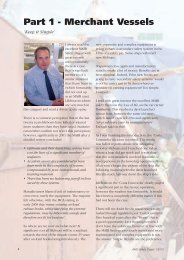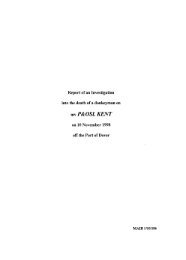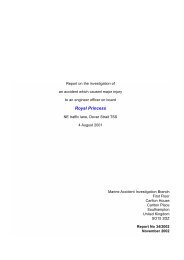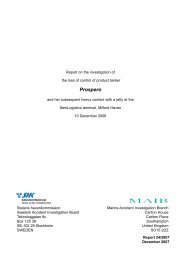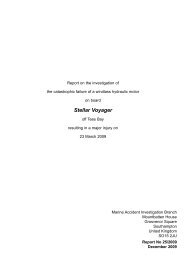SECTION 4 - Marine Accident Investigation Branch
SECTION 4 - Marine Accident Investigation Branch
SECTION 4 - Marine Accident Investigation Branch
You also want an ePaper? Increase the reach of your titles
YUMPU automatically turns print PDFs into web optimized ePapers that Google loves.
1.6 CASUALTIES<br />
1.6.1 Fourth officer<br />
The 27 year-old, British fourth officer qualified as a deck officer on 25 November<br />
2011. Among other STCW-related qualifications, he was awarded a Proficiency<br />
in Survival Craft and Rescue Boats certificate on 29 October 2011. Since joining<br />
Saga Sapphire on 2 February 2012, he had been mainly engaged in lifeboat<br />
maintenance duties. At the time of the accident, he was recorded on the crew list<br />
as a supernumerary; soon after the accident, he was signed on as the ship’s fourth<br />
officer.<br />
1.6.2 First cook<br />
The 43 year-old, Filipino first cook joined Saga Sapphire on 2 March 2012. This<br />
was his first ship since completing his Basic Safety, Crowd Management, Personal<br />
Survival and First Aid training in Manila, Philippines on 14 February 2012. He<br />
was awarded his Ship Familiarisation Certificate on 9 March 2012. He had also<br />
completed the Saga Safety at Work and Manual Handling Courses on board the<br />
ship.<br />
1.7 REFIT-RELATED ASPECTS<br />
1.7.1 Vessel structural changes and their implications for passengers and crew<br />
On the purchase of Bleu de France, Acromas Shipping Ltd made a commercial<br />
decision to fully refurbish the public rooms, modify the passengers’ accommodation<br />
and amend manning levels to suit its business model criterion of single-sitting<br />
dining. The strategy included the planned reduction in passenger berths from<br />
1048 to 706 against a maximum of 730 permitted by the Passenger Ship Safety<br />
Certificate (PSSC). To improve the passenger to crew ratio, it was also planned to<br />
increase crew levels, from 366 to 428, well within the maximum of 470 allowed. The<br />
planned changes resulted in a total of 1134 persons on board against a maximum<br />
permissible of 1200 persons.<br />
To compensate for the calculated increase in the ship’s lightship condition following<br />
the structural changes, a number of heavy items were removed from the ship.<br />
These included cranes, cargo hatch, the swimming pool magnadome and the after<br />
passenger swimming pool. Because of the reduction in passenger levels, Nos 1 and<br />
2 open lifeboats were no longer required and so were also removed to reduce the<br />
total weight of the ship.<br />
It was later discovered that the remaining 10 lifeboats, tenders and rescue boats<br />
were overweight. This resulted in a further, unintended, reduction in passenger<br />
and crew levels. Because of the lifeboat issues, GL issued the ship with its Record<br />
of Equipment for the Interim PSSC (Form P), instead of a full PSSC, on 30 March<br />
2012, which was valid until 29 August 2012. The document certified that a maximum<br />
of 1010 persons could be carried on board, of whom 600 could be passengers and<br />
the remaining 410 crew. This represented an 18% reduction on potential passenger<br />
berth sales against the planned passenger profile.<br />
15


